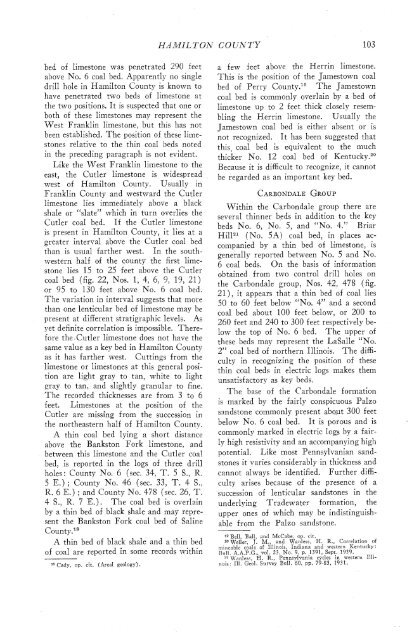subsurface geology and coal resources of the pennsylvanian system ...
subsurface geology and coal resources of the pennsylvanian system ...
subsurface geology and coal resources of the pennsylvanian system ...
You also want an ePaper? Increase the reach of your titles
YUMPU automatically turns print PDFs into web optimized ePapers that Google loves.
HB&lILTON COUNTY 103<br />
bed <strong>of</strong> limestone was penetrated 290 feet<br />
above No. 6 <strong>coal</strong> bed. Apparently no single<br />
drill hole in Hamilton County is known to<br />
have penetrated two beds <strong>of</strong> limestone at<br />
<strong>the</strong> two positions. It is suspected that one or<br />
both <strong>of</strong> <strong>the</strong>se limestones may represent <strong>the</strong><br />
West Franklin limestone, but this has not<br />
been established. The position <strong>of</strong> <strong>the</strong>se limestones<br />
relative to <strong>the</strong> thin <strong>coal</strong> beds noted<br />
in <strong>the</strong> preceding paragraph is not evident.<br />
Like <strong>the</strong> West Franklin limestone to <strong>the</strong><br />
east, <strong>the</strong> Cutler limestone is widespread<br />
west <strong>of</strong> Hamilton County. Usually in<br />
Franklin County <strong>and</strong> westward <strong>the</strong> Cutler<br />
limestone lies immediately above a black<br />
shale or "slate" which in turn overlies <strong>the</strong><br />
Cutler <strong>coal</strong> bed. If <strong>the</strong> Cutler limestone<br />
is present in Hamilton County, it lies at a<br />
greater interval above <strong>the</strong> Cutler <strong>coal</strong> bed<br />
than is usual far<strong>the</strong>r west. In <strong>the</strong> southwestern<br />
half <strong>of</strong> <strong>the</strong> county <strong>the</strong> first limestone<br />
lies 15 to 25 feet above <strong>the</strong> Cutler<br />
<strong>coal</strong> bed (fig. 22, Nos. 1, 4, 6, 9, 19, 21)<br />
or 95 to 130 feet above No. 6 <strong>coal</strong> bed.<br />
The variation in interval suggests that more<br />
than one lenticular bed <strong>of</strong> limestone may be<br />
present at different stratigraphic levels. As<br />
yet definite correlation is impossible. Therefore<br />
<strong>the</strong>-Cutler limestone does not have <strong>the</strong><br />
same value as a key bed in Hamilton County<br />
as it has far<strong>the</strong>r west. Cuttings from <strong>the</strong><br />
limestone or limestones at this general position<br />
are light gray to tan, white to light<br />
gray to tan, <strong>and</strong> slightly granular to fine.<br />
The recorded thicknesses are from 3 to 6<br />
feet.<br />
Limestones at <strong>the</strong> position <strong>of</strong> <strong>the</strong><br />
Cutler are missing from <strong>the</strong> succession in<br />
<strong>the</strong> nor<strong>the</strong>astern half <strong>of</strong> Hamilton County.<br />
A thin <strong>coal</strong> bed lying a short distance<br />
above <strong>the</strong> Bankston Fork limestone, <strong>and</strong><br />
between this limestone <strong>and</strong> <strong>the</strong> Cutler <strong>coal</strong><br />
bed, is reported in <strong>the</strong> logs <strong>of</strong> three drill<br />
holes: County No. 6 (sec. 34, T. 5 S., R.<br />
5 E.) ; County No. 46 (sec. 33, T. 4 S.,<br />
R. 6 E.) ; <strong>and</strong> County No. 478 (sec. 26, T.<br />
4 S., R. 7 E.). The <strong>coal</strong> bed is overlain<br />
by a thin bed <strong>of</strong> black shale <strong>and</strong> may represent<br />
<strong>the</strong> Bankston Fork <strong>coal</strong> bed <strong>of</strong> Saline<br />
County.*8<br />
A thin bed <strong>of</strong> black shale <strong>and</strong> a thin bed<br />
<strong>of</strong> <strong>coal</strong> are reported in some records within<br />
IS Cady, op. cit. (Areal <strong>geology</strong>).<br />
a few feet above <strong>the</strong> Herrin limestone.<br />
This is <strong>the</strong> position <strong>of</strong> <strong>the</strong> Jamestown <strong>coal</strong><br />
bed <strong>of</strong> Perry County.lg The Jamestown<br />
<strong>coal</strong> bed is commonly overlain by a bed <strong>of</strong><br />
limestone up to 2 feet thick closely resembling<br />
<strong>the</strong> Herrin limestone. Usually <strong>the</strong><br />
Jamestown <strong>coal</strong> bed is ei<strong>the</strong>r absent or is<br />
not recognized. It has been suggested that<br />
this* <strong>coal</strong> bed is equivalent to <strong>the</strong> much<br />
thicker No. 12 <strong>coal</strong> bed <strong>of</strong> Kent~cky.~'<br />
Because it is difficult to recognize, it cannot<br />
be regarded as an important key bed.<br />
Within <strong>the</strong> Carbondale group <strong>the</strong>re are<br />
several thinner beds in addition to <strong>the</strong> key<br />
beds No. 6, No. 5, <strong>and</strong> "No. 4." Briar<br />
Hi1121 (NO. 5A) <strong>coal</strong> bed, in places accompanied<br />
by a thin bed <strong>of</strong> limestone, is<br />
generally reported between No. 5 <strong>and</strong> No.<br />
6 <strong>coal</strong> beds. On <strong>the</strong> basis <strong>of</strong> information<br />
obtained from two control drill holes on<br />
<strong>the</strong> Carbondale group, Nos. 42, 478 (fig.<br />
21), it appears that a thin bed <strong>of</strong> <strong>coal</strong> lies<br />
50 to 60 feet below "No. 4" <strong>and</strong> a second<br />
<strong>coal</strong> bed about 100 feet below, or 200 to<br />
260 feet <strong>and</strong> 240 to 300 feet respectively below<br />
<strong>the</strong> top <strong>of</strong> No. 6 bed. The upper <strong>of</strong><br />
<strong>the</strong>se beds may represent <strong>the</strong> LaSalle "No.<br />
2" <strong>coal</strong> bed <strong>of</strong> nor<strong>the</strong>rn Illinois. The difficulty<br />
in recognizing <strong>the</strong> position <strong>of</strong> <strong>the</strong>se<br />
thin <strong>coal</strong> beds in electric logs makes <strong>the</strong>m<br />
unsatisfactory as key beds.<br />
The base <strong>of</strong> <strong>the</strong> Carbondale formation<br />
is marked by <strong>the</strong> fairly conspicuous Palzo<br />
s<strong>and</strong>stone commonly present about 300 feet<br />
below No. 6 <strong>coal</strong> bed. It is porous <strong>and</strong> is<br />
commonly marked in electric lcgs by a fairly<br />
high resistivity <strong>and</strong> an accompanying high<br />
potential. Like most Pennsylvanian s<strong>and</strong>stones<br />
it varies considerably in thickness <strong>and</strong><br />
cannot always be identified. Fur<strong>the</strong>r difficulty<br />
arises because <strong>of</strong> <strong>the</strong> presence <strong>of</strong> a<br />
succession <strong>of</strong> lenticular s<strong>and</strong>stones in <strong>the</strong><br />
underlying Tradewater formation, <strong>the</strong><br />
upper ones <strong>of</strong> which may be indistinguishable<br />
from <strong>the</strong> Palzo s<strong>and</strong>stone.<br />
1"ell. Ball, <strong>and</strong> McCabe, op. cit.<br />
20 Weller, J. M., <strong>and</strong> Wanless, H. R Correlation <strong>of</strong><br />
mineable <strong>coal</strong>s <strong>of</strong> Illinois, Indiana <strong>and</strong> we'stern Kentucky:<br />
Bull. A.A.P.G., vol. 23, No. 9, p. .1391, Sept. 1939.<br />
'1 wanless, H. R., Pennsylvama cycles in wester11 Illinois:<br />
Ill. Geol. Survey Bull. 60, pp. 79-83, 1931.
















